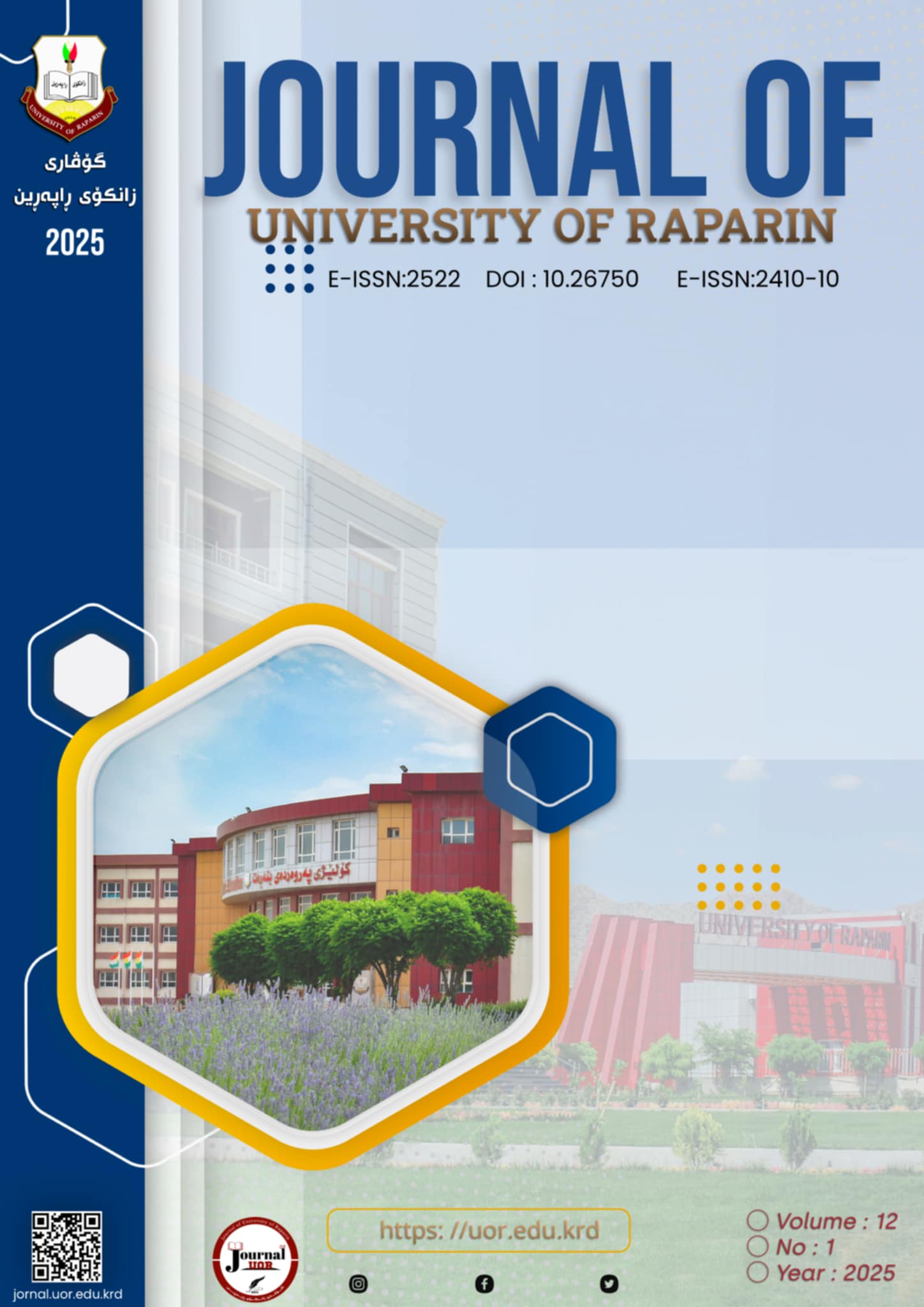Abstract
The Ministry of Education (MOE-KRG) conducted a campaign for raising awareness among students, parents and local communities. Despite this operation and many other efforts by the Kurdistan Regional Government to reform the education sector targeting all aspects, numerous challenges remain that are hereditary and persistent. These challenges involve socioeconomic, institutional, and cultural dimensions and factors. This research paper studied these factors enumerating the differences between genders and between urban and rural areas in the Kurdistan region. This paper analyzed survey data officially obtained from the MOE-KRG using quantitative approaches. This paper conducted multiple Pearson’s Chi-Square tests and cross-tabulation analyses. Results indicated that there are statically significant differences between male students and female students in terms of child labor, disabilities, and school distance, which dropping out rates among male students were higher than those of female students due to these factors. Furthermore, dropping out of school was more common among seventh graders. Hence, it is essential to expand the role of the social workers in schools to support students and reduce rates of dropping out of schools, in addition to raising awareness in the communities and implement policy reform in the education system.
References
Archer, L. (2003) Race, Masculinity and Schooling: Muslim Boys and Education. Maidenhead: Open University Press.
Balfanz, R., Bridgeland, J., Moore, L., & Fox, J. H. (2014). Building a Grad Nation: Progress and Challenge in Ending the High School Dropout Epidemic. Civic Enterprises, the Everyone Graduates Center at Johns Hopkins University, and the Bill & Melinda Gates Foundation.
Bandura, A. (1977). Social Learning Theory. Englewood Cliffs, NJ: Prentice Hall.
Becker, G.S. (1993). Human Capital: A Theoretical and Empirical Analysis, with Special Reference to Education. Chicago: University of Chicago Press.
Black’s Law Dictionary (2019) Legal Definitions. Available at: https://www.blackslawdictionary.com/ (Accessed: 28 December 2024).
Blumer, H. (1969). Symbolic Interactionism: Perspective and Method. Berkeley: University of California Press.
Borjas, G. J. (1995) Ethnicity, Neighborhoods, and Human Capital Externalities. In: Borjas, G. J. (ed.) Issues in the Economics of Immigration. Chicago: University of Chicago Press, pp. 79-121. https://doi.org/10.1142/9789811240812_0007
Bourdieu, P. (1977) Cultural Reproduction and Social Reproduction. In: Karabel, J. and Halsey, A. H. (eds.) Power and Ideology in Education. New York: Oxford University Press, pp. 487-511.
Bourdieu, P. (1986). The Forms of Capital. In: Richardson, J. (ed.) Handbook of Theory and Research for the Sociology of Education. Westport: Greenwood Press, pp. 241-258.
Bronfenbrenner, U. (1979). The Ecology of Human Development: Experiments by Nature and Design. Cambridge, MA: Harvard University Press.
Catterall, J. S. (1998). Capital to the future: The social, cultural, and academic engagement of high school dropouts. Educational Evaluation and Policy Analysis, 20(4), 315-326.
Coleman, J.S. (1988). 'Social Capital in the Creation of Human Capital', American Journal of Sociology, 94(Supplement), S95-S120. https://www.journals.uchicago.edu/doi/abs/10.1086/228943
Dika, S. L. and Singh, K. (2002) 'Applications of Social Capital in Educational Research: A Critical Synthesis', Review of Educational Research, 72(1), pp. 31-60.
https://journals.sagepub.com/doi/abs/10.3102/00346543072001031
Freire, P. (1970). Pedagogy of the Oppressed. New York: Continuum.
Gottfredson, D.C. and Skroban, S.A., 2000. The school environment and student engagement: The role of school safety, teacher-student relationships, and extracurricular activities. Journal of Educational Research, 93(3), pp.179-190.
Khan, M., Ahmad, A., & Ali, S. (2020). Factors Influencing Student Dropout Rates in the Kurdistan Region: A Comprehensive Study. Journal of Education and Practice, 11(15), 45-56
KRG. (2016). Social Protection System Report. Kurdistan Regional Government. Available at: https://us.gov.krd/media/1317/social-protection-strategic-framework.pdf. (Accessed Day:27/12/2024).
KRG. (2020). Kurdistan Regional Government Annual Report. Erbil: Kurdistan Regional Government. Available at: https://gov.krd/english/
(MOE-KRG) (2021) Annual Education Report. Available at https://gov.krd/moe-en/ (Accessed: 28 December 2024)
KRG. (2022). Education Sector Development Plan. Kurdistan Regional Government. Available at: https://gov.krd/english/government/the-prime-minister/activities/?year=2022.(Accessed Day:27/12/2024).
Merton, R.K. (1938). 'Social Structure and Anomie', American Sociological Review, 3(5), pp. 672-682. Available at: https://www.jstor.org/stable/2084686.
Oxford University Press (2024) Oxford English Dictionary. Available at: https://www.oed.com/ (Accessed: 28 December 2024).
Rudaw(2015). UN: More than 127,000 out-of-school children in Kurdistan Region 16-04-2015. Available at : https://www.rudaw.net/english/kurdistan/16042015?utm_source=chatgpt.com (Accessed Day:27/12/2024).
Rumberger, R. W. (2001). Why students drop out of school and what can be done. In Dropouts in America: Confronting the Graduation Rate Crisis (pp. 131-156). Washington, DC: National Academy Press.
Rumberger, R. W., & Lim, S. A. (2008). Why do students drop out of school? In Handbook of Adolescent Behavioral Problems (pp. 145-156). New York: Springer.
Sabarwal, S. and Sellen, R. (2014) 'Cultural Alignment and Student Success in Education', Educational Studies, 40(1), pp. 50-64.
UNESCO. (2020). Education in the Kurdistan Region: Policy Analysis and Recommendations. United Nations Educational, Scientific and Cultural Organization.
UNESCO. (2021). Education in the Kurdistan Region of Iraq: A Review of the Current Status and Future Directions. UNESCO Publishing.
UNICEF. (2020). Iraq education fact sheets. Analyses for learning and equity using MICS data. Available at:https://data.unicef.org/wp-content/uploads/2021/08/2020-IRAQ-Education-Factsheets_UNICEF_English_Final.pdf. (Accessed Day:27/12/2024).
United Nations (1989) Convention on the Rights of the Child. Available at: https://www.un.org/en/documents/crc/ (Accessed: 28 December 2024).
Willms, J. D. (2000) Socioeconomic Status and Educational Achievement: A Review of the Literature. Paris: Organisation for Economic Co-operation and Development (OECD). Available at :https://www.jstor.org/stable/canajeducrevucan.32.3.558
World Bank (2021). Kurdistan Region Education Sector Analysis. World Bank Group. Available at: https://www.worldbank.org
Yusuf, M. (2020). Education in Kurdistan: Challenges and Opportunities. Journal of Kurdish Studies. Available at: https://kurdishstudies.net. (Accessed Day:12/05/2024)

This work is licensed under a Creative Commons Attribution-NonCommercial-NoDerivatives 4.0 International License.
Copyright (c) 2025 Journal of University of Raparin

